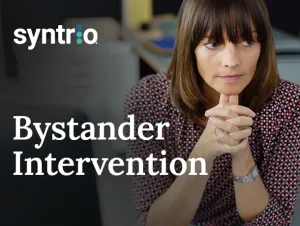Workplace Stalkers and Bystander Intervention
When stalking affects an employee, do you know what to do?
Stalking In the Workplace
Although stalkers are sometimes unknown to the victims, they can be acquaintances, business associates, customers, or most often, a current or former domestic partner. In those cases, stalking is an attempt to monitor, intimidate, and control the targeted person.
The National Intimate Partner and Sexual Violence Survey reports that about 1 in 3 women and 1 in 6 men have been stalked at some point in their lives. Due to social stigmas and fear of not being believed, victims may find it difficult to discuss the situation with their employers.
Stalking can escalate to workplace violence. It’s critical that employees feel safe alerting their managers and security personnel so steps can be taken to help ensure everyone’s safety in the workplace.
Intimate Partner Stalking
An En Avant Toute(s) research study found that stalking creates even more difficulties when the harasser is a coworker.
- Work is often the only place where intimate partner violence victims can seek help. Coworkers may be their only ally.
- It can be difficult to avoid an abuser who is part of the target’s professional network.
- Due to the financial freedom work provides, it is often a target of abuse.
A survey by the Society of Human Resource Management (SHRM) indicates most organizations are unsure what to do if both the stalker and targeted person are employees of the organization.
A SHRM article by Roy Maurer quotes nationally recognized expert on domestic violence Meagan Newman on what an organizational policy needs to address:
- Conduct that occurs off-duty.
- Security concerns.
- Violations of an employment agreement or other condition of employment.
- Non-actionable conduct that nonetheless needs to be addressed because the issue is disrupting the work environment.
Bystander Intervention
It’s important for organizations to have a plan for workplace stalking. In addition, there are steps individual employees who suspect stalking can take to help:
- If you think there is an immediate threat, alert your manager, security personnel, or emergency responders.
- Otherwise, start a conversation with the person you suspect is a victim. According to the National Domestic Violence Hotline, you should do this confidentially and by saying something like, “I’ve been worried about you because I’ve noticed…”
- Understand that the person may not be ready to talk.
- If they share details with you, listen without judgment or trying to solve the problem for them.
- Encourage them to alert their manager to the situation.
- Be prepared to discuss your organization’s resources that could help them, such as employee assistance programs, local, state, and national hotlines, and other resources.
- Continue to show concern and support for the coworker. Your concern lets them know they are not alone, which can empower them to seek help. It may give them the courage to take action when they are ready. It also validates their sense of worth and their perception that something is wrong. This is important in cases where an abuser is gaslighting them.
Train Your Employees
Targeted people who may feel too embarrassed to discuss their problems with their managers will sometimes confide in their coworkers. Our bystander intervention training teaches employees how to recognize and overcome their hesitations (called the bystander effect) and safely address situations of unsafe or improper conduct. Our training provides positive, proactive steps for various situations, including harassment such as stalking, bullying, and safety concerns.
Contact us today to empower your workforce to intervene if it is safe to do so, and to record and report their concerns according to your organization’s policy.


